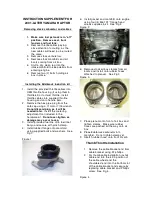
Combination headlights and dimmer switch
Features and controls 5-145
5
Your vehicle speed does not exceed
approximately 28 mph (45 km/h).
It is bright ahead of your vehicle.
An exterior light of a vehicle in front or
oncoming vehicle is illuminating.
The sensitivity of the sensor can be temporar-
ily lowering in the following ways.
NOTE
The headlights may not be switched from
high beam to low beam under the following
circumstances.
• A vehicle in front or oncoming vehicle is
hindered by any object such as continuous
bends, elevated median/island, traffic signs,
roadside trees.
• Your vehicle passes an oncoming vehicle
suddenly on a bend with poor visibility.
• Another vehicle crosses ahead of your vehi-
cle.
The headlights may remain at low beam (or
be switched from high beam to low beam)
when a reflective object (e.g. street light,
traffic signal, noticeboard and signboard)
reflects light.
Any of the following factors may influence
the headlight beam switching timing:
• How brightly the exterior lights of a vehicle
in front or oncoming vehicle illuminate.
• Movement or direction of a vehicle in front
or oncoming vehicle.
• Only right or left exterior light of a vehicle
in front or oncoming vehicle is illuminat-
ing.
• A vehicle in front or oncoming vehicle is a
motorcycle.
• Road conditions (gradient, bends and road
surface).
• The number of occupants and luggage load.
The Automatic High Beam (AHB) recog-
nises environmental conditions by sensing a
light source ahead of your vehicle. There-
fore, you may feel like something is not quite
right when the headlight beams are switched
automatically.
The system may not detect a light vehicle
such as a bicycle.
The system may not detect an ambient
brightness precisely. This causes the traffic
to be dazzled by high beam or the low beam
to be maintained. In such cases, you should
switch the headlight beams manually.
• In bad weather (heavy rain, fog, snow or
sandstorm).
• The windshield is dirty or fogged up.
• The windshield is cracked or broken.
• The sensor is deformed or dirty.
• A light, which is similar to the headlights or
tail lights, is shining around your vehicle.
• A vehicle in front or oncoming vehicle is
driven without lights, the exterior lights are
dirty or discoloured, or the direction of the
headlight beams is adjusted improperly.
• It becomes dark and bright suddenly and
continuously around your vehicle.
• Your vehicle is driven on uneven surfaces.
NOTE
• Your vehicle is driven on a winding road.
• A reflective object such as a noticeboard or
a mirror reflects a light ahead of your vehi-
cle.
• When lights of the vehicle in front or head-
lights of an oncoming vehicle blend into the
other lights.
• The rear end of a vehicle in front (such as a
container truck) reflect a strong light.
• Your vehicle’s headlight is broken or dirty.
• Your vehicle is inclined due to a flat tire or
towing.
• The warning display appears.
(Refer to “System problem warning” on
page 5-146.)
Observe the precautions below to maintain
good usage conditions:
• Do not attempt to disassemble the sensor.
• Do not affix a sticker or label on the wind-
shield near the sensor.
• Avoid overload.
• Do not modify your vehicle.
• When the windshield is replaced, use the
Mitsubishi Motors genuine parts.
To adjust the sensitivity of the sensor
NOTE
BK0251800US.book 145 ページ 2017年5月18日 木曜日 午後2時48分
Summary of Contents for Outlander Sport 2018
Page 237: ...BK0251800US book 174 ページ 2017年5月18日 木曜日 午後2時48分 ...
Page 251: ...BK0251800US book 14 ページ 2017年5月18日 木曜日 午後2時48分 ...
Page 289: ...BK0251800US book 16 ページ 2017年5月18日 木曜日 午後2時48分 ...
Page 339: ...BK0251800US book 6 ページ 2017年5月18日 木曜日 午後2時48分 ...
Page 351: ...BK0251800US book 6 ページ 2017年5月18日 木曜日 午後2時48分 ...
















































